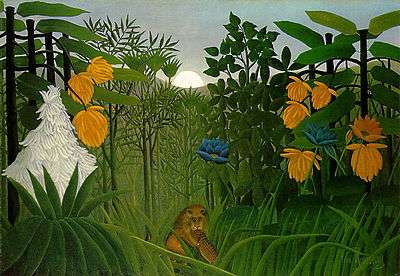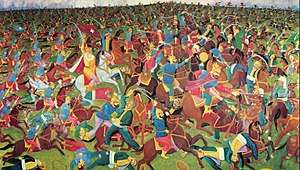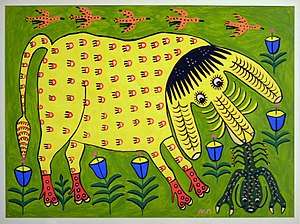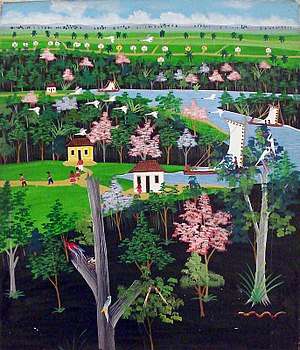Naïve art
Naïve art is usually defined as visual art that is created by a person who lacks the formal education and training that a professional artist undergoes (in anatomy, art history, technique, perspective, ways of seeing).[1] When this aesthetic is emulated by a trained artist, the result is sometimes called primitivism, pseudo-naïve art,[2] or faux naïve art.[3]

Unlike folk art, naïve art does not necessarily derive from a distinct popular cultural context or tradition;[1] indeed, at least in the advanced economies and since the Printing Revolution, awareness of the local fine art tradition has been inescapable, as it diffused through popular prints and other media. Naïve artists are aware of "fine art" conventions such as graphical perspective and compositional conventions, but are unable to fully use them, or choose not to. By contrast, outsider art (art brut) denotes works from a similar context but which have only minimal contact with the mainstream art world.
Naïve art is recognized, and often imitated, for its childlike simplicity and frankness.[4] Paintings of this kind typically have a flat rendering style with a rudimentary expression of perspective.[5] One particularly influential painter of "naïve art" was Henri Rousseau (1844–1910), a French Post-Impressionist who was discovered by Pablo Picasso.
The definition of the term, and its "borders" with neighbouring terms such as folk art and outsider art, has been a matter of some controversy. Naïve art is a term usually used for the forms of fine art, such as paintings and sculptures, but made by a self-taught artist, while objects with a practical use come under folk art. But this distinction has been disputed.[6] Another term that may be used, especially of paintings and architecture, is "provincial", essentially used for work by artists who had received some conventional training, but whose work unintentionally falls short of metropolitan or court standards.
Characteristics

Naïve art[7] is often seen as outsider art that is by someone without formal (or little) training or degree. While this was true before the twentieth century, there are now academies for naïve art. Naïve art is now a fully recognized art genre, represented in art galleries worldwide.
The characteristics of naïve art are an awkward relationship to the formal qualities of painting, especially not respecting the three rules of the perspective (such as defined by the Progressive Painters of the Renaissance):
- Decrease of the size of objects proportionally with distance,
- Muting of colors with distance,
- Decrease of the precision of details with distance,
The results are:
- Effects of perspective geometrically erroneous (awkward aspect of the works, children's drawings look, or medieval painting look, but the comparison stops there)
- Strong use of pattern, unrefined color on all the plans of the composition, without enfeeblement in the background,
- An equal accuracy brought to details, including those of the background which should be shaded off.
Simplicity rather than subtlety are all supposed markers of naïve art. It has, however, become such a popular and recognizable style that many examples could be called pseudo-naïve.
Whereas naïve art ideally describes the work of an artist who did not receive formal education in an art school or academy, for example Henri Rousseau or Alfred Wallis, 'pseudo naïve' or 'faux naïve' art describes the work of an artist working in a more imitative or self-conscious mode and whose work can be seen as more imitative than original.
Strict naïvety is unlikely to be found in contemporary artists, given the expansion of Autodidactism as a form of education in modern times. Naïve categorizations are not always welcome by living artists,[8][9] but this is likely to change as dignifying signals are known. Museums devoted to naïve art now exist in Kecskemét, Hungary; Riga, Latvia; Jaen, Spain; Rio de Janeiro, Brasil; Vicq France and Paris. Examples of English-speaking living artists who acknowledge their naïve style are: Gary Bunt,[10] Lyle Carbajal,[11] Gabe Langholtz,[12] Gigi Mills,[13] Barbara Olsen,[14] Paine Proffitt,[15] and Alain Thomas.[16]
"Primitive art" is another term often applied to art by those without formal training, but is historically more often applied to work from certain cultures that have been judged socially or technologically "primitive" by Western academia, such as Native American, subsaharan African or Pacific Island art (see Tribal art). This is distinguished from the self-conscious, "primitive" inspired movement primitivism. Another term related to (but not completely synonymous with) naïve art is folk art.
There also exist the terms "naïvism" and "primitivism" which are usually applied to professional painters working in the style of naïve art (like Paul Gauguin, Mikhail Larionov, Paul Klee).[17]
Movements
Nobody knows exactly when the first naive artists appeared on the scene, as from the very first manifestations of art right up to the days of the "Modern Classic", naive artists quite unconsciously bequeathed us unmistakable signs of their creative activity. At all events, naive art can be regarded as having occupied an "official" position in the annals of twentieth-century art since - at the very latest - the publication of the Der Blaue Reiter, an almanac in 1912. Wassily Kandinsky and Franz Marc, who brought out the almanac, presented 6 reproductions of paintings by le Douanier' Rousseau (Henri Rousseau), comparing them with other pictorial examples. However, most experts agree that the year that naive art was "discovered" was 1885, when the painter Paul Signac became aware of the talents of Henri Rousseau and set about organizing exhibitions of his work in a number of prestigious galleries.[18]
Earth Group
The Earth Group (Grupa Zemlja) were Croatian artists, architects and intellectuals active in Zagreb from 1929 to 1935. The group was Marxist in orientation and was partly modelled on "Neue Sachlichkeit",[19] leading to more stylized forms, and the emergence of Naive painting. The group included the painters Krsto Hegedušić, Edo Kovačević, Omer Mujadžić, Kamilo Ružička, Ivan Tabaković, and Oton Postružnik, the sculptors Antun Augustinčić, Frano Kršinić, and the architect Drago Ibler. The Earth group searched for answers to social issues. Their program emphasised the importance of independent creative expression, and opposed the uncritical copying of foreign styles. Rather than producing art for art's sake, they felt it ought to reflect the reality of life and the needs of the modern community. Activities at the group's exhibitions were increasingly provocative to the government of the day, and in 1935 the group was banned.[20]
Hlebine School
A term applied to Croatian naive painters working in or around the village of Hlebine, near the Hungarian border, from about 1930. At this time, according to the World Encyclopedia of Naive Art (1984), the village amounted to little more than ‘a few muddy winding streets and one-storey houses’, but it produced such a remarkable crop of artists that it became virtually synonymous with Yugoslav naive painting.[21]
Hlebine is a small picturesque municipality in the North of Croatia that in 1920s became a setting against which a group of self-taught peasants began to develop a unique and somewhat revolutionary style of painting. This was instigated by leading intellectuals of the time such as the poet Antun Gustav Matoš and the biggest name in Croatian literature, Miroslav Krleža, who called for an individual national artistic style that would be independent from Western influences. These ideas were picked up by a celebrated artist from Hlebine – Krsto Hegedušić and he went on to found the Hlebine School of Art in 1930 in search of national “rural artistic expression”.[22]
Ivan Generalić was the first master of the Hlebine School, and the first to develop a distinctive personal style, achieving a high standard in his art.[23]
After the Second World War, the next generation of Hlebine painters tended to focus more on stylized depictions of country life taken from imagination. Generalić continued to be the dominant figure, and encouraged younger artists, including his son Josip Generalić.
The Hlebine school became a worldwide phenomenon with the 1952 Venice Biennale and exhibitions in Brazil and Brussels.[24]
Some of the best known naive artists are Dragan Gaži, Ivan Generalić, Josip Generalić, Krsto Hegedušić, Mijo Kovačić, Ivan Lacković-Croata, Franjo Mraz, Ivan Večenaj and Mirko Virius.
Artists
18th century

.jpg)
- Oluf Braren (1787–1839)
- Justus DaLee (1793–1878)
- Edward Hicks (1780–1849)
- Joshua Johnson (1763-1824)
19th century
- James Bard (1815–1897)[25]
- Ilija Bašičević (1895–1972)
- André Bauchant (1873–1958)
- Camille Bombois (1883–1970)
- Sam Byrne (1883-1978)
- Charles Callins (1887-1982)
- Ferdinand Cheval, known as 'le facteur Cheval' (1836–1924)
- Denys Corbet (1826–1910)
- Henry Darger (1892–1973)
- Theora Hamblett (1895–1977)
- Mary Jewels (1886-1977)
- John Kane (1860–1934)
- Alena Kish (1889 or 1896–1949) Belarus
- Arnold Kramer (1882–1976)
- Olof Krans (1838-1916)
- Antonio Ligabue (1899–1965)
- Cándido López (1840–1902)
- Séraphine Louis, known as 'Séraphine de Senlis' (1864–1942)
- L. S. Lowry (1887–1976)
- Grandma Moses, Anna Mary Robertson (1860–1961)
- Nikifor (1895–1968) Poland
- Teofil Ociepka (1891–1978) Poland
- Horace Pippin (1888–1946)
- Niko Pirosmani (1862–1918) Georgia
- Peter Rindisbacher (1806–1834) USA, b. Switzerland
- Bárbaro Rivas (1893–1967) Venezuela
- Henri Rousseau (1844–1910) France
- Jon Serl (1894-1993) United States
- Matija Skurjeni (1898–1990) Croatia
- Henry Stockley (1892–1982), Great Britain
- Lavoslav Torti (1875–1942) Croatia
- Mirko Virius (1889–1943) Croatia
- Miguel García Vivancos (1895–1972)
- Louis Vivin (1861–1936)
- Alfred Wallis (1855–1942)
- Scottie Wilson (1890–1972)
- Ellinor Aiki (1893-1969)
20th century

- Gesner Abelard (b. 1922)
- Andreas Alariesto (1900-1989) Finland
- Alyona Azernaya (b. 1966) Russia
- Francis Bacon (1909-1992)
- Jan Bacur (b. 1937) Serbia
- Jan Balet (1913–2009)
- Nina Barka (Marie Smirsky) (1908–1986)
- Kateryna Bilokur (1900-1961) Ukraine
- Janko Brašić (1906–1994)
- Frédéric Bruly Bouabré (b. 1923)
- Eugen Buktenica (1914–1997) Croatia
- Zuzana Chalupová (1925–2001) Kovačica (Vojvodina) Serbia
- Paulina Constancia (b. 1970) Philippines
- Michel Delacroix (b. 1933) France
- Préfète Duffaut (b. 1923)
- Emerik Feješ (1904–1969) Croatia
- Howard Finster (1916–2001)
- Robert-Émile Fortin (1945–2004) Canada
- Lucy Fradkin (b. 1953) United States
- George Fredericks (b. 1929)
- José Rodríguez Fuster (b. 1946) Cuba
- Dragan Gaži (1930-1983) Croatia
- Ivan Generalić (1914–1992) Hlebine, Croatia
- Josip Generalić (1935–2004) Hlebine, Croatia
- Mokarrameh Ghanbari (1928–2005) Iran
- Petronėlė Gerlikienė (1905–1979)
- Petar Grgec (1933–2006) Croatia
- James Hampton (1909-1964), United States
- Krsto Hegedušić (1901–1975) Croatia
- Jan Husarik (b. 1942) Padina, Serbia
- Daniel Johnston (1961-2019) Austin, United States
- Drago Jurak (1911–1994) Croatia
- Bob Justin (b. 1941)
- Ferenc Kalmar (b. 1928)
- Mijo Kovačić (b. 1935) Croatia
- Siegfried L. Kratochwil (1916–2005) Austria
- Ivan Lacković Croata (1932–2004) Croatia
- Pavel Leonov (1920–2011) Russia
- Maud Lewis (1903-1970) Canada
- Manuel Lepe Macedo (1936–1984)
- Ferreira Louis Marius (b. 1953)
- Katya Medvedeva (b. 1937) Russia
- Martin Mehkek (1936-2014) Croatia
- Manuel Mendive (b. 1944) Cuba
- Dobrosav Milojevic (b. 1948) Serbia[26]
- Ethel Wright Mohamed (1906-1992) USA
- Franjo Mraz (1910–1981) Hlebine, Croatia
- Navitrolla (b. 1970) Estonia
- Radi Nedelchev (b. 1938)
- Norman Neasom (1915–2010)
- Mary Nohl (1914–2001) Fox Point, Wisconsin
- Derold Page (b. 1947)
- Stan Ioan Pătraş (1908–1977) Romania
- Bryan Pearce (1929–2007)
- Mario Perez (b. 1943)
- Nan Phelps (1904–1990) USA
- Maria Pryimachenko (1908–1997) Ukraine
- Oles Semernya (1936–2012) Ukraine
- Polina Raiko (1927–2004) Ukraine
- Alevtina Pyzhova (born 1936) Russia
- Ivan Rabuzin (1921–2008) Croatia
- Markey Robinson (1918–1999) Ireland
- Konstantin Rodko (1908–1995)
- Vasily Romanenkov (1953–2013) Russia
- Heinz Seelig (1909–1992) Israel
- Yeshayahu Sheinfeld (1909-1979) Israel[27]
- Mary Michael Shelley (b. 1950)
- Chris (Simpsons artist) (b. 1983) England
- Petar Smajić (1910–1985) Croatia
- Peter Smith (b. 1967)
- Slavko Stolnik (1929–1991) Croatia
- Bunleua Sulilat (1932–1996)
- Dragiša Stanisavljević (b. 1921)
- Chaibia Talal (1929–2004)
- Bracha Turner (b. 1922)
- Claudia Vecchiarelli (1978–2009) Italy
- Ivan Večenaj (1920–2013) Croatia
- Guido Vedovato (b. 1961) Italy
- Arthur Villeneuve (1910–1990) Canada
- Elena Volkova (1915–2013)
- Sergey Zagraevsky (b. 1964) Russia
- Raphael Perez (b. 1965) Israel
- Fred Yates (1922–2008)
- Eremenko Irina (1919–2007) Russia
Museums and galleries

- Belgium
- Brazil
- International Museum of Naive Art of Brazil in Cosme Velho, Rio de Janeiro
- Gallery Jacques Ardies in São Paulo
- Canada
- Croatia
- Croatian Museum of Naïve Art in Zagreb[28]
- Gallery of Croatian Naïve Art in Zagreb[29]
- Croatian Naive Art Museum in Hlebine
- Estonia
- Finland
- France
- Musée international d'Art naïf Anatole Jakovsky in Nice[30]
- Musée d'Art Naïf - Max Fourny in Paris
- International Museum of Naive Art in Vicq (near Versailles)[31]
- Museum of Naive Art in Beraut (near Toulouse)
- Germany
- Hungary
- Israel
- Latvia
- Nicaragua
- Philippines
- Portugal
- Museu De Arte Primitiva Moderna in Guimarães
- Russia
- Serbia
- Museum of Naïve and Marginal Art in Jagodina
- Gallery of Naive Art in Kovačica
- Slovenia
- Spain
- Ukraine
- USA
- Anthony Petullo Collection of Self-Taught & Outsider Art
- American Visionary Art Museum in Baltimore, MD
- Venezuela
- Museo Nacional de Arte Popular
Associations
- Folk Art Society of America
- ABNA - British Naive Art Association
- Israel Naive art Association
- Nederland Naive Art Association
- Naive Art Association of Denmark
- France Naive Art Group
References
- Benedetti, Joan M. (19 April 2008). "Folk Art Terminology Revisited: Why It (Still) Matters". In Roberto, K. R. (ed.). Radical Cataloging: Essays at the Front. McFarland. p. 113. ISBN 978-1-4766-0512-8.
- Risatti, Howard (15 September 2009). "Aesthetics and the Function/Nonfunction Dichotomy". A Theory of Craft: Function and Aesthetic Expression. Chapel Hill: University of North Carolina Press. p. 223. ISBN 978-0-8078-8907-7. OCLC 793525283.
- Levy, Silvano (2008). Lines of Thought: The Drawings of Desmond Morris. Kettlestone: Kettlestone Press. p. 138. ISBN 978-0-9560153-0-3. OCLC 377804527.
- Walker, John Albert (26 April 1992). Glossary of Art, Architecture, and Design Since 1945. London: Library Association Publishing. p. 433. ISBN 978-0-85365-639-5. OCLC 26202538.
- Matulka, Denise I. (2008). "Anatomy of a Picture Book: Picture, Space, Design, Medium, and Style § Naïve Art". A Picture Book Primer: Understanding and Using Picture Books. Westport: Libraries Unlimited. p. 80. ISBN 978-1-59158-441-4. OCLC 225846825.
- Wertkin, Gerard C. (2004). "Introduction". In Wertkin, Gerald C. Encyclopedia of American Folk Art. New York, London: Routledge. pp. xxxiv–xxxvi.
- Nathalia Brodskaïa L'Art naïf éd. Parkstone International ISBN 9781859956687
- Geller, Amy. "Lure of the Naïve" (PDF). amygellerillustration.com/. Archived from the original (PDF) on September 4, 2012. Retrieved July 12, 2016.
- [translation, [text] Natalia Brodskaia; Darton], adaptation Mike (2000). Naïve art. New York: Parkstone Press. p. 74. ISBN 1859953352.
- "Gary Bunt, English Village Life". www.artistsandart.org. Retrieved July 12, 2016.
- "Lyle Carbajal: Painting". www.notey.com. Retrieved July 12, 2016.
- "Gabe Langholtz Naive Modern". www.saatchiart.com. Archived from the original on September 21, 2016. Retrieved July 12, 2016.
- "Gigi Mills". www.askart.com. Retrieved July 12, 2016.
- "Biography Barbara Olsen". www.barbaraolsen.com. Retrieved July 12, 2016.
- "All Work: Paine Proffitt". www.acframinggallery.co.uk. Retrieved July 12, 2016.
- "Alain THOMAS, an artist in the Garden of Eden". www.alain-thomas.com. Retrieved July 12, 2016.
- Irina Arnoldova. Painter Sergey Zagraevsky: the view of an art critic
- "WetCanvas: Articles: Jan and Adrie Martens: An Introduction to Naive Art". www.wetcanvas.com. Retrieved 2016-03-17.
- "I_CAN - Texts - page sent at 2005/04/13 17:54". www.c3.hu. Retrieved 2016-03-17.
- "I_CAN - Texts - page sent at 2005/04/13 17:54". www.c3.hu. Retrieved 2016-03-17.
- "Hlebine School - oi". Cite journal requires
|journal=(help) - "Hlebine School of Art: More than peasant doodles". MoonProject. Retrieved 2016-03-17.
- Otvorena.hr, Otvorena mreza -. "The Croatian Museum of Naive Art - Guide to the Permanent Display". www.hmnu.org. Archived from the original on 2013-09-27. Retrieved 2016-03-17.
- DK Eyewitness Travel Guide: Croatia. Penguin. 2015-04-07. ISBN 9781465441737.
- Mariner's Museum and Peluso, Anthony J., Jr., The Bard Brothers -- Painting America under Steam and Sail, Abrams, New York 1997 ISBN 0-8109-1240-6
- Permanent member of Museum of Naïve and Marginal Art Archived 2012-02-22 at the Wayback Machine in Jagodina
- Listed artist by The Israel Museum in Jerusalem
- "Croatian Museum of Naive Art". Archived from the original on 9 May 2012. Retrieved 25 February 2011.
- "Gallery of Croatian Naive Art".
- "Musée international d'Art naïf Anatole Jakovsky". Cote.azur.fr.
- "International Museum of Naive Art". Midan.org. Archived from the original on 2001-12-02.
- Museum.hu: Museum of Hungarian Naive Artists (Kecskemét) (in Hungarian)
- Spain.info: Museo Internacional de Arte Naïf "Manuel Moral" - Manuel Moral International Museum of Naïve Art
Further reading
| Wikimedia Commons has media related to Naïve art. |
- Walker, John. "Naive Art". Glossary of Art, Architecture & Design since 1945, 3rd. ed. (archived link, April 11, 2012)
- Bihalji-Merin, Oto (1959). Modern Primitives: Masters of Naive Painting. trans. Norbert Guterman. New York: Harry N. Abrams.
- Fine, Gary Alan (2004). Everyday genius: self-taught art and the culture of authenticity. Chicago, IL: University Of Chicago Press. ISBN 978-0-226-24950-6.